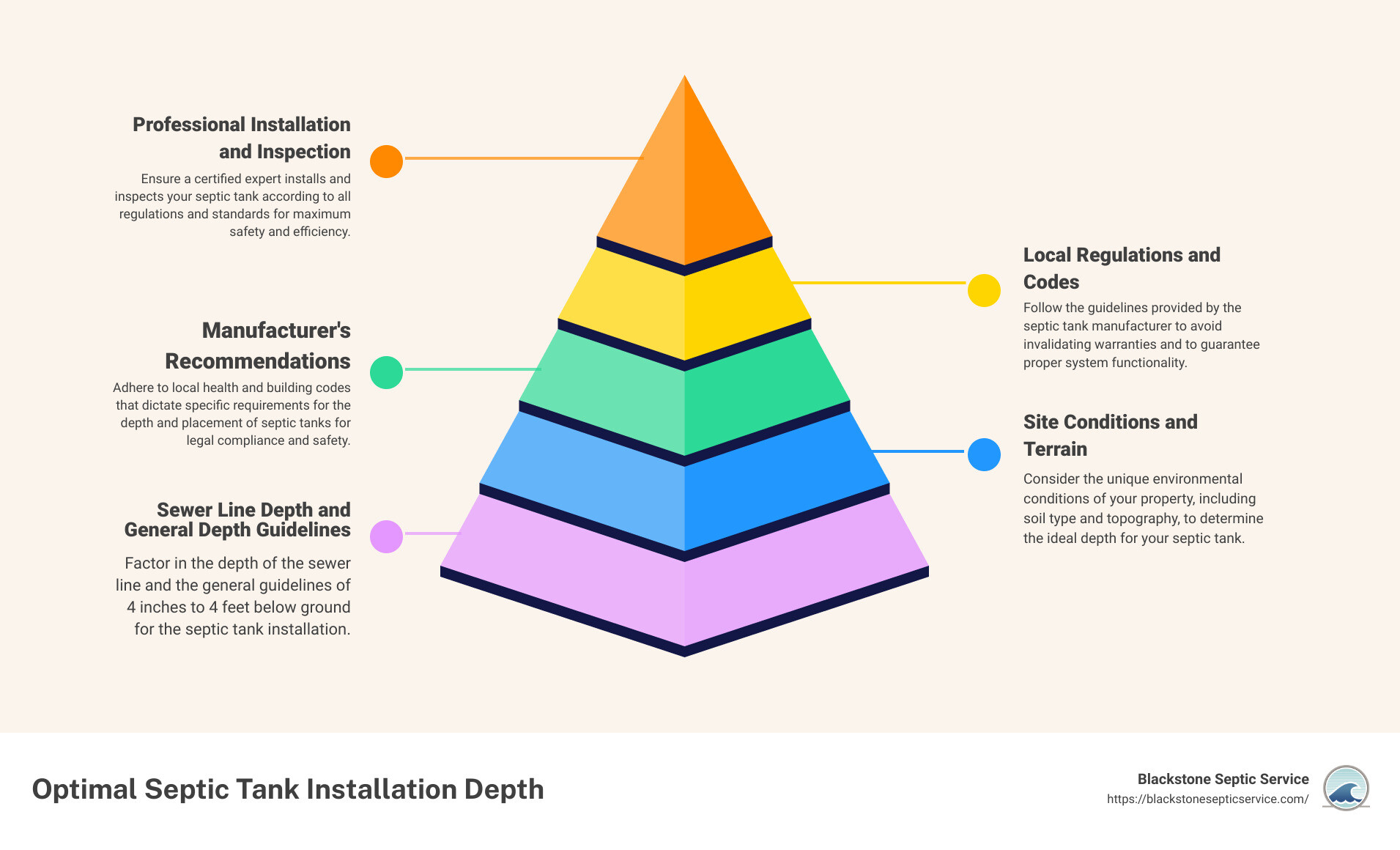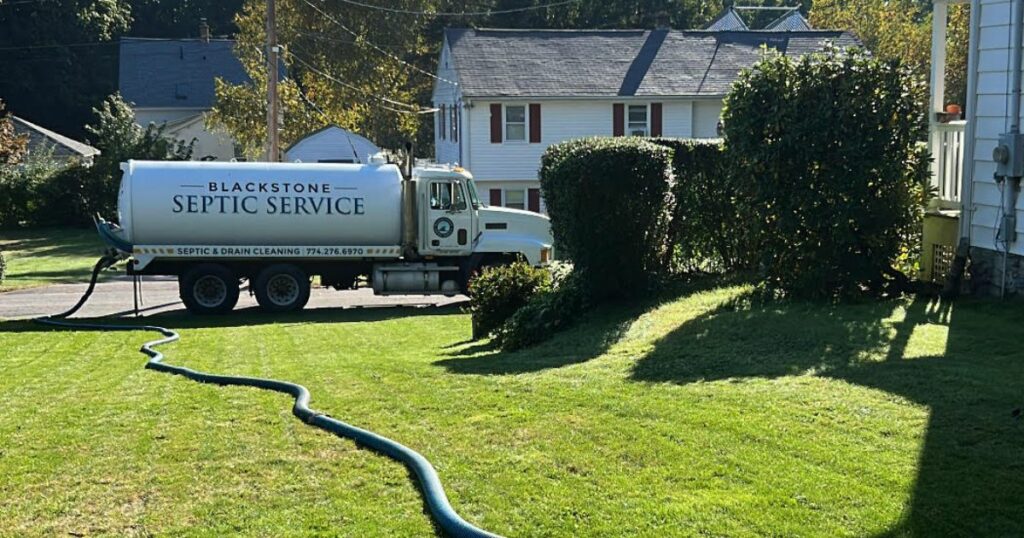Do you know how deep your septic tank should be? If you’re like most homeowners, you probably haven’t given much thought to it.
However, the depth at which your septic tank is installed plays a crucial role in its function and longevity. This is why we at Blackstone Septic Service are here to help you understand and determine the ideal depth for your septic tank.
A septic tank is an essential component of a home’s wastewater treatment system, especially in areas where access to a city sewer system is not available.
These tanks, usually made of concrete, plastic, or fiberglass, can naturally separate solid waste from wastewater, with tank capacity anywhere between 1,000 and 3,500 gallons.
The tank materials of a septic system can have an impact on the durability and maintenance requirements of the system. For example, concrete tanks may be more susceptible to cracking over time compared to plastic or fiberglass tanks.
So, it is important to use online information as a general guideline for your questions and concerns.
Septic Tank Location: How Deep Should a Septic Tank Be?
While the benefits of a septic system are numerous, it is important to install these systems at an optimum depth.
Installation depth can vary between 4 inches to 4 feet below the ground surface on average, depending on factors like sewer line depth, local regulations, and terrain characteristics.
Adhering to these depth guidelines is not optional, as it can directly affect the functionality of your septic system.
5 Steps to Determine the Ideal Septic Tank Depth:
- Understand the basics of septic tank installation and how they function.
- Assess the factors that influence the depth of the septic tank, such as terrain, site conditions, sewer line depth, manufacturer’s guidelines, and local regulations.
- Determine the ideal depth for your septic tank, generally between 4 inches to 4 feet below ground level.
- Ensure the installation is done correctly and safely, ideally by a professional service provider like us at Blackstone Septic Service.
- Maintain your septic system post-installation through regular inspection, pumping, and following best practices to prolong its lifespan.

Arming yourself with this knowledge can ensure proper maintenance and long-lasting service from your septic system.
Table of Contents
Join us as we explore how to determine septic tank installation depth in five easy steps.
Step 1: Understanding the Basics of Septic Tank Installation
Before we delve into the specifics of how deep should a septic tank be, understand the basics of septic installation and its role in wastewater management.
At Blackstone Septic Service, we believe that a well-informed homeowner is the best partner in maintaining a healthy and efficient septic system.
The Role of Septic Tanks in Wastewater Management
Every household generates wastewater, a combination of blackwater (toilet waste) and graywater (kitchen, bathtub, and laundry waste).
So where does all this wastewater go? The answer is your septic tank.
A septic tank is a crucial component of any septic system. It’s an underground tank where the initial phase of wastewater treatment begins. Its primary role is to separate and break down solid waste.
The separation process allows solids to settle at the bottom of the tank, forming a sludge layer, while lighter materials like oil and grease, float to the top, forming a scum layer.
Beyond treating household waste, a well-maintained septic system also plays a crucial role in protecting the environment. By cleaning the water before it reenters the groundwater, it contributes to conserving our precious water resources.
Main Components of a Septic System: Septic Tank and Absorption Area
A septic system has two main components: the septic tank and an absorption area, also known as a leach field. The septic is typically buried about six feet deep and ten feet away from the building.
It collects and separates solid waste into sludge and scum while allowing effluent to flow to the absorption area.
The absorption area is where the liquid effluent percolates into the ground. Soil in this area acts as a natural filter, removing some bacteria and viruses from the effluent.
Most of the liquid from the absorption field eventually seeps down to the groundwater.
How Septic Tanks Work: Collecting Solids and Separating Liquids
The septic system’s operation is a process of separation and decomposition. Understanding the operation of a septic tank is crucial for proper maintenance and ensuring effective wastewater treatment.
The key points in the separation process of septic tanks include:
- Separation and Decomposition: Solids settle at the bottom to form the sludge layer. Fats and oils float to the top, creating the scum layer. The liquid in the middle, known as effluent, remains relatively clear.
- Effluent Treatment: Effluent is the treated liquid that is allowed to flow to the second chamber or directly to the leach field for further treatment.
- Outlet Pipe: The outlet pipe is essential for directing the treated effluent to the next stage in the wastewater management process. Outlet pipes play an important part in proper flow and prevention of backups within the septic systems.
- Bacterial Action: Bacteria in the septic aid in breaking down solids, reducing their volume, and preventing the accumulation of sludge.
- Septic Pumping: Regular septic pumping is vital to remove remaining sludge that bacteria might not break down completely, preventing system failure.
Understanding these basics is the first step in determining the depth of your septic installation. In the next section, we’ll explore the factors that influence this crucial decision.
Step 2: Factors Influencing Septic Tank Installation Depth

When it comes to determining how deep a septic should be, several factors come into play.
These factors range from the physical characteristics of your property to local building codes and regulations.
Understanding these factors will help you make an informed decision about the optimal depth for your septic system.
Terrain and Site Conditions
The characteristics of your property significantly affect the depth of your septic system installation.
If there are obstacles on your property like bedrock or large trees, these might require the tank to be buried deeper.
Additionally, if the tank has to be positioned further from your home due to these hurdles, it will likely be buried deeper to aid gravity in moving wastewater into the tank.
Sewer Line Depth
The depth of your main sewer line also plays an essential role in determining the depth of your septic tank. Since the main sewer line carries all the wastewater out of your home, it’s logical that your septic tank should be at a similar depth or just below it to use gravity to the system’s advantage.
Local Codes and Regulations for Massachusetts Septic Tank Depths
Finally, local building codes and regulations can influence the depth of your septic tank installation.
In Massachusetts, only certified installers, registered environmental health specialists, licensed professional engineers, or those under their direct supervision are permitted to install septic tanks, ensuring adherence to rigorous regulations for proper wastewater management and environmental protection agency.
At Blackstone Septic Service, we understand that the process of determining the ideal depth for your septic can be complex and challenging. That’s why we’re here to help.
In the next section, we’ll talk about how to determine the ideal depth for your septic tank based on these factors.
Step 3: Determining the Ideal Depth for Your Septic Tank
Now that you’re familiar with the factors that influence the depth of your septic, it’s time to figure out the ideal depth for your septic tank.
While there are general guidelines, your specific situation may require a different approach.
General Depth Guidelines: Depth of a Septic Tank
As a rule of thumb, your septic may be buried anywhere from 4 inches to 4 feet below the surface of the earth.
Determining the ideal depth for a septic involves considering factors such as local building codes, soil composition, groundwater proximity, bedrock depth, distance from the home, and accessibility for maintenance.
Local regulations guide depth specifications, while soil type influences drainage and bedrock depth impacts installation. The distance to the house affects the required burial depth for proper wastewater flow.
In conclusion, a balanced evaluation of these factors, with input from local authorities and professionals, informs the optimal septic tank depth.
What is the Average Minimum and Maximum Depth of a Septic Tank?
- Minimum Depth: The septic tank should have a minimum burial depth of 4 inches below the surface of the earth. This minimum depth ensures the protection of the tank and its components while allowing for proper insulation.
- Maximum Depth: The maximum burial depth for a septic tank is generally recommended to be 4 feet below the surface. This upper limit takes into account factors such as the height of the bedrock in your area and the distance between your home and the septic tank.
It’s important to note that the depth of the septic tank is not directly tied to its size. Whether you have a 1,000-gallon septic tank or a different capacity, the burial depth can vary within the specified range based on the unique characteristics of your property.
Always consult with local authorities and professionals to determine the specific depth requirements for your septic system based on your property’s conditions.
What Happens if the Septic Tank is Installed too Close to the Ground Surface?
If a septic is installed too close to the surface of the ground, it can have several negative impacts on the sewer pipe and the overall septic system.
Here are some potential issues of installing septic tanks too close to the surface:
- Damage to Sewer Pipes: Shallow septic tank placement can lead to damage or deformation of sewer pipes due to soil pressure.
- Structural Integrity Risk: The weight of the soil can compromise the septic tank’s structural integrity, risking collapse or deformation.
- Inefficient Treatment: Inadequate soil cover can result in poor wastewater treatment, affecting the separation of solids and compromising effluent quality.
- Surface Water Exposure: Shallow placement increases the risk of surface water infiltration during heavy rainfall, potentially causing backups.
- Odor Issues: Improperly sealed shallow tanks may release unpleasant odors, impacting the surrounding environment.
- Regulatory Violations: Violating minimum depth regulations can lead to legal and environmental compliance issues.
Consulting with a professional septic system installer or engineer is recommended to ensure proper installation and compliance with regulations.
Considerations for Septic Drain Lines: 18 to 36 Inches Underground
When it comes to the septic drain lines, they are typically buried between 18 and 36 inches underground.
The pipes are surrounded by gravel and sand to aid in the filtration and water treatment process.
However, some septic drain lines may be buried just 6 inches under the ground.
Step 4: Ensuring Safe and Effective Septic Installation
Installing a septic tank isn’t a simple task that you can do in a DIY manner.
Ensuring safe and effective septic tank installation is a complex process that demands attention to detail and professional expertise. Attempting a DIY installation without the necessary knowledge can lead to serious consequences, including health hazards and costly repairs.
The process begins with a professional assessment of site conditions, such as soil composition and local regulations, to determine the appropriate tank size and type. Precise excavation and placement, following safety standards, are crucial to avoid damage to structures and utilities.
Professional installers also educate homeowners on maintenance and obtain necessary permits, ensuring a septic system that meets environmental standards and reduces the risk of complications.
Importance of Professional Installation and Inspection
The installation depth of a septic tank is just one piece of the puzzle. There are numerous factors to consider, from the type of soil on your property to local regulations and codes.
Determining the correct installation depth is crucial, but so is ensuring the tank is level, the connections are sealed, and the system is tested for leaks.
Furthermore, a professional inspection can confirm that your septic tank and drain lines are properly installed and functioning. In addition, regular sewage ejector pump repairs and maintenance play a vital role in the overall health of your septic system.
This provides peace of mind that your system will work efficiently and effectively for years to come.
Risks of Incorrect Installation Depth: Tank Collapse, Groundwater Contamination, and Impact on Drinking Water
If a septic tank is not installed at the correct depth, it could collapse under the weight of the soil above it or from heavy equipment or vehicles passing overhead. This would not only be a costly mistake to repair, but it could also pose a serious safety risk.
Moreover, if the septic tank is installed too close to the ground’s surface, there’s a higher risk of groundwater contamination.
Contaminated groundwater can pose serious health risks and lead to environmental damage.
Therefore, proper installation depth is crucial to safeguarding the integrity of drinking water supplies and preventing adverse health effects.
Blackstone Septic Service: Your Trusted Partner for Septic Tank Installation
At Blackstone Septic Service, we understand the intricacies of septic system installation. We’re here to help you determine how deep your septic tank should be, based on a thorough evaluation of your specific circumstances.
Our team comprises experienced technicians who are well-versed in local regulations and best practices for septic system installation.
Aside from the installation, we also provide regular septic cleaning services to maintain the longevity of your septic system.
A well-installed and maintained septic system can last up to 40 years. So, it’s worth investing in professional installation and regular maintenance right from the start.
As a family-owned business, we value honesty, reliability, and superior customer service. We’re here to guide you every step of the way, ensuring your septic system is installed correctly and operates efficiently for years to come.
Step 5: Maintaining Your Septic System Post-Installation

Once your septic system is installed at the correct depth, consistent maintenance is crucial to keep it functioning optimally. Here are some key aspects to consider.
Regular Inspection and Pumping: Every 2 to 4 Years
Regular inspection and pumping of your septic system are crucial to its longevity. If you’re wondering how often to pump your septic tank, a general guideline is every 2 to 4 years.
However, this can vary depending on the size of your household and usage. Getting your septic tank pumped and inspected regularly can help identify potential issues early on, thereby preventing costly repairs down the line.
Do’s and Don’ts: Avoiding Harmful Chemicals and Excessive Waste
Be mindful of what you flush down the toilet or drain. Besides human waste and toilet paper, avoid flushing items such as feminine products, wipes, and cigarette butts.
These can clog your system and cause serious problems. Similarly, avoid using harsh cleaning chemicals or antifreeze, which can harm the bacteria essential for breaking down waste in your septic tank.
Another important aspect is to avoid placing unnecessary weight over your drain field. This includes driving vehicles over it or placing heavy equipment like above-ground pools or storage sheds.
These can potentially damage the pipes or the tank itself.
4 Tips for Concealing Septic Tank Lids
While it’s important to know how deep should septic tank be, you may also be interested in how to aesthetically integrate it into your landscape.
Here are a few ways that you can conceal your septic tanks:
- Decorative Lid Covers: Choose from various designs to seamlessly blend with your yard. Aesthetic option to conceal tank exposed areas.
- Painting: Match the lid color with your lawn to create a cohesive look. Simple yet effective way to integrate the tank into the landscape.
- Landscaping: Plant around the tank with shallow-rooted plants to conceal exposed areas, including the septic tank lid. Conceals the tank lid while preventing potential damage.
- Maintenance Importance: Post-installation maintenance is crucial for septic system longevity. Enhances efficiency and extends the system’s lifespan.
In conclusion, maintaining your septic system post-installation is as important as determining the ideal depth for its installation. It not only enhances the system’s efficiency but also extends its lifespan.
At Blackstone Septic Service, we’re committed to providing top-notch septic services and helping you maintain your system in the best possible way.
Recap on How to Determine the Actual Septic Tank Depth
Knowing how deep should a septic tank be is crucial for its effective functioning and longevity.
Determining the correct depth for your septic tank is only the beginning. Maintaining the septic system post-installation is paramount to ensure its optimal functioning and longevity.
Regular inspections, pumping every 2-4 years, and being mindful of what goes into the system are all part of this process.
Improper or incorrect installation can lead to a range of problems, from tank collapse to groundwater contamination. That’s why we, at Blackstone Septic Service, always stress the importance of professional installation and regular maintenance.
Our team is dedicated to providing fast, reliable, and affordable services to homeowners in Central MA and surrounding areas.
If you have any questions or need help with septic system maintenance or installation, don’t hesitate to contact us at Blackstone Septic Service. We’re here to help you if you are planning to install a septic tank!
Our Content
Our experienced septic tank specialists have carefully reviewed and edited all of the content to ensure that it meets our high standards for quality and accuracy. At Blackstone Septic Service, our mission is to provide unparalleled expertise and service excellence in the realm of septic system care. With a dedicated team of professionals committed to delivering top-tier solutions, we specialize in comprehensive services encompassing everything from existing system routine maintenance like septic tank pumping and cleaning to intricate repairs, septic inspection, knowledge of septic components, new tank installations, septic tank design, maintenance intervals, and new septic tank system installations.
Customer satisfaction is at the core of our operations, and we pride ourselves on our prompt, reliable, and customer-centric approach. Blackstone Septic Service is a family owned company with highly trained technicians, with over 75 years of experience in septic tanks.



